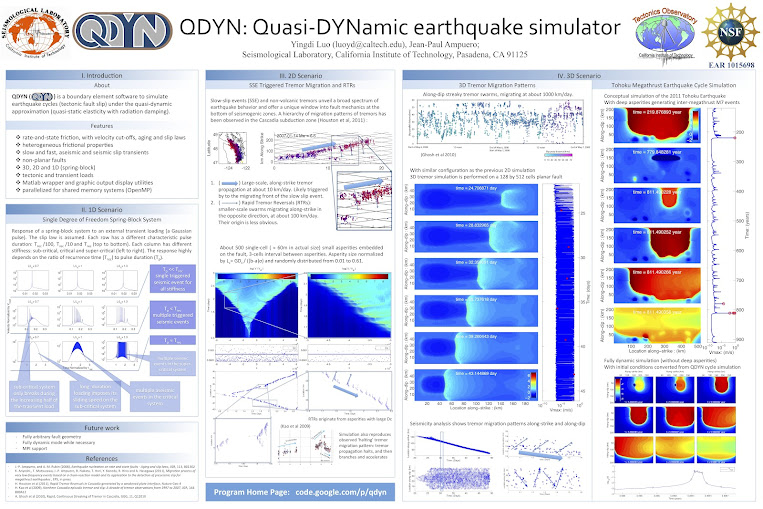QDYN is a boundary element software to simulate earthquake cycles (seismic and aseismic slip on tectonic faults) under the quasi-dynamic approximation (quasi-static elasticity combined with radiation damping) on faults governed by rate-and-state friction and embedded in elastic media.
QDYN includes various forms of rate-and-state friction and state evolution laws, and handles non-planar fault geometry in 3D and 2D media, as well as spring-block simulations. Loading is controlled by remote displacement, steady creep or oscillatory load. In 3D it handles free surface effects in a half-space, including normal stress coupling. The medium surrounding the fault is linear, isotropic and elastic, and may be uniform or (in 2D) contain a damaged layer.
QDYN implements adaptive time stepping, shared-memory parallelization, and can deal with multi-scale earthquake cycle simulations with fine details in both time and space. It is equipped with user-friendly MATLAB and Python interfaces and graphical output utilities.
To get started with QDYN, see the documentation.
-
rate-and-state friction, with velocity cut-offs, aging and slip laws
-
microphysically based frictional model (Chen-Niemeijer-Spiers model)
-
heterogeneous frictional properties
-
slow and fast, aseismic and seismic slip transients
-
dynamic weakening (thermal pressurization)
-
non-planar faults (currently limited to variable dip, rectangular elements)
-
3D, 2D and 1D (spring-block)
-
tectonic and transient loads
-
normal stress coupling
-
faults surrounded by damaged zones
-
MATLAB and Python wrappers, and graphic output display utilities
-
parallelized for shared memory systems (OpenMP)
-
parallelized for distributed memory systems (MPI)
22 July 2020 | QDYN version 2.3 has arrived! In this release we improved the output modules, making them more consistent across simulation features and paving the way for HDF5 support. See the release notes for details.
24 June 2020 | Article published on modeling earthquake cycles on heterogeneous faults using the CNS microphysical model: M. van den Ende, J. Chen, J.P. Ampuero and A. Niemeijer, Rheological transitions facilitate fault‐spanning ruptures on seismically active and creeping faults, J. of Geophys. Res.: Solid Earth (doi:10.1029/2019JB019328)
January 2020 | The QDYN team participated in the Community Code Verification Exercise for Simulating Sequences of Earthquakes and Aseismic Slip (SEAS), funded by SCEC. The results of this community benchmark exercise are now published in Seismological Research Letters (see also this preprint on EarthArXiv). A script to run these simulations in QDYN is included in the /examples/scec_benchmarks/BP2 directory.
29 August 2019 | QDYN version 2.2 has been released! This version is now more user-friendly than QDYN has ever been, with a new documentation website, Jupyter Notebooks, and automated testing for developers. See the release notes for details.
21 August 2019 | QDYN version 2.1 has been released! See the release notes for new features and (minor) bug fixes.
13 June 2019 | Article published on modeling earthquake cycles on geometrically-complex fault systems with the QDYN-SPECFEM Bridge:
P. Galvez, P. Somerville, A. Petukhin, J. P. Ampuero and D. Peter, Earthquake cycle modelling of multi-segmented faults: dynamic rupture and ground motion simulation of the 1992 Mw 7.3 Landers earthquake, Pure Appl. Geophys., doi:10.1007/s00024-019-02228-x
24 April 2019 | Recent work using QDYN earthquake cycle simulations to constrain seismic hazard models:
L. Ceferino, P. Galvez, J. P. Ampuero, A. Kiremidjian, G. Deierlin and J. C. Villegas-Lanza, Bayesian parameter estimation for space and time interacting earthquake rupture model using historical and physics-based simulated earthquake catalogs, pre-print, doi:10.31223/osf.io/3wfr4
11 December 2018 | QDYN version 2.0 has been released!
6 December 2018 | Results of QDYN earthquake cycle simulations on faults surrounded by damaged zones were presented at:
- the AGU Fall Meeting 2017 (San Francisco, 11-15 December 2017): B. Idini and J. P. Ampuero, Rupture complexity promoted by damaged fault zones in earthquake cycle models (doi:10.1002/essoar.10500080.1, poster)
- the 10th ACES International Workshop (Japan, September 25-28, 2018), J. P. Ampuero et al., Rupture complexity promoted by damaged fault zones in earthquake cycle models (slides)
- the Workshop on Modeling Earthquake Source Processes (Caltech, October 8-10, 2018).
29 November 2018 | The QDYN team participated in in the two first benchmarks and workshops of the SCEC SEAS project (Southern California Earthquake Center, Sequences of Earthquakes and Aseismic Slip). Yingdi Luo presented work using QDYN on A heterogenous fault model of episodic tremor and slow-slip events with spatial-temporal variability (slides).
11 September 2018 | Results based on QDYN were highlighted at the 2018 WEGENER conference in the keynote presentation The spectrum of slip behaviors emerging from the interactions between seismic and aseismic slip by J. P. Ampuero (slides).
28 May 2018 | In order to address a problem in the QDYN history tree, the version history of the QDYN repository was rewritten. All developers that have cloned the QDYN repository before this date should follow the steps described in this manual. Users of QDYN that did not make any code changes can simply delete the old repository and clone the latest version to get a clean QDYN repository.
May 2018 | Two papers with simulation results based on QDYN, published in Tectonophysics - Special Issue on "Physics of Earthquake Rupture Propagation":
M. van den Ende, J. Chen, J. P. Ampuero and A. Niemeijer
A comparison between rate-and-state friction and microphysical models, based on numerical simulations of fault slip (doi:10.1016/j.tecto.2017.11.040)
Y. Luo and J. P. Ampuero
Stability and effective friction of faults with heterogeneous friction properties and fluid pressure (doi:10.1016/j.tecto.2017.11.006)
Apr 2017 | Earthquake cycle simulations with a micro-physics model of granular flow and ductile creep of fault gouges based on QDYN presented at the EGU General Assembly 2017, session on Earthquakes: from slow to fast, from the field to the laboratory:
M. van den Ende, J. Chen, J. P. Ampuero and A. Niemeijer (2017)
Earthquake and slow-slip nucleation investigated with a micro-physics based seismic cycle simulator
Geophysical Research Abstracts, Vol. 19, EGU2017-7249
Abstract PDF -- Presentation PPT
Feb 2017 | QDYN v1.1 has been released and published online via zenodo. This new version introduces MPI parallelization for 3D simulations in HPC clusters and faults surrounded by damaged zones in 2D. You can cite it as:
Y. Luo, J. P. Ampuero, P. Galvez, M. van den Ende and B. Idini (2017)
QDYN: a Quasi-DYNamic earthquake simulator (v1.1)
Zenodo. doi:10.5281/zenodo.322459
Jan 2017 | In the following paper we used QDYN to simulate earthquake cycles and obtained events spanning a broad range of magnitudes to study earthquake scaling relations:
Y. Luo, J. P. Ampuero, K. Miyakoshi and K. Irikura (2017)
Surface effects on earthquake moment-area scaling relations
PAGEOPH, Topical Volume on "Best Practices in Physics-based Fault Rupture Models for Seismic Hazard Assessment of Nuclear Installations" doi:10.1007/s00024-017-1467-4
PDF
Nov 2014 | A QDYN tutorial session was offered at the School on "Earthquakes: nucleation, triggering and relationship with aseismic processes" at Cargese, Corsica, 3 - 10 November 2014
QDYN was previously hosted on GoogleCode and is now on Github. Both SVN and GIT version control systems are supported.
Previous (stable) versions of QDYN can be downloaded from the release page. Development versions are available as separate branches following the naming convention release/x.x.x.
To install QDYN please follow the Getting started section in the documentation.
Questions, feedback or suggestions can be submitted via our issue tracking system.
(listed alphabetically)
Jean-Paul Ampuero (IRD/UCA, Géoazur, France; Caltech Seismolab, USA)
Martijn van den Ende (Université Côte d'Azur, Géoazur, France)
Percy Galvez (KAUST, Saudi Arabia; AECOM, Switzerland)
Benjamin Idini (Caltech Seismolab, USA)
Yingdi Luo (NASA JPL, USA)
Luo, Y., Ampuero, J. P., Galvez, P., van den Ende, M., & Idini, B. (2017).
QDYN: a Quasi-DYNamic earthquake simulator (v1.1) [Data set]. Zenodo. doi:10.5281/zenodo.322459
Luo, Y., & Ampuero, J. P. (2018). Stability of faults with heterogeneous friction properties and effective normal stress. Tectonophysics, 733, 257-272, doi:10.1016/j.tecto.2017.11.006
Luo, Y., Ampuero, J. P., Miyakoshi, K., & Irikura, K. (2017). Surface rupture effects on earthquake moment-area scaling relations. Pure and Applied Geophysics, 174(9), 3331-3342, doi:10.1007/s00024-017-1467-4.
In Topical Volume on "Best Practices in Physics-based Fault Rupture Models for Seismic Hazard Assessment of Nuclear Installations".
PDF
Luo, Y., & Ampuero, J. P. (2012), Simulation of Complex Tremor Migration Patterns, AGU Fall Meeting 2012 Abstract S44B-02
Luo, Y., & Ampuero, J. P. (2011), Numerical Simulation of Tremor Migration Triggered by Slow Slip and Rapid Tremor Reversals, AGU Fall Meeting 2011, abstract S33C-02
van den Ende, M. P. A., Chen, J., Ampuero, J. P., & Niemeijer, A. R. (2018). A comparison between rate-and-state friction and microphysical models, based on numerical simulations of fault slip. Tectonophysics, 733, 273-295, doi:10.1016/j.tecto.2017.11.040
Idini, B., & Ampuero, J. P. (2017).
Rupture complexity promoted by damaged fault zones in earthquake cycle models.
AGU Fall Meeting 2017, abstract T41C-0632.
Poster PDF, doi:10.1002/essoar.10500080.1




